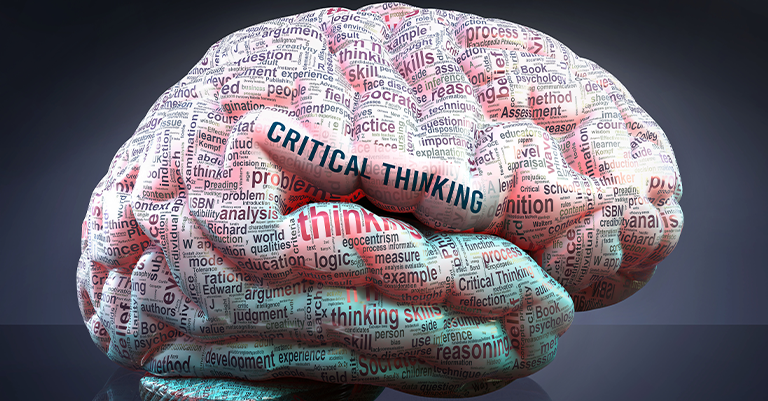Leaders are expected to make tough decisions every day, often under pressure. To be effective, they need more than quick thinking or intuition—they need critical thinking. Mastering this skill and a handful of other skills helps leaders make confident, informed decisions that benefit their teams and organizations. In this post, we’ll explore why critical thinking is essential for leadership and how mastering it can transform decision-making.
What is Critical Thinking in Leadership?

In leadership, critical thinking is the process of analyzing information and making decisions based on logical reasoning. It involves breaking down complex problems, examining data objectively, and considering all possible outcomes before deciding on a course of action.
Leaders who think critically don’t jump to conclusions or rely solely on their gut feelings. Instead, they ask the right questions, gather relevant facts, and weigh the pros and cons of each option. This approach ensures that decisions are well thought out and based on evidence, not assumptions.
Critical thinking also helps leaders stay grounded. In an environment where quick decisions are often needed, being a critical thinker allows a leader to pause, reflect, and choose wisely. This skill is key to guiding teams through challenging situations with confidence.
Key Components of Critical Thinking for Leaders
Effective leadership requires several components of critical thinking:
- Analysis: Leaders break down complex problems into smaller, manageable parts.
- Objectivity: They remove personal bias, focusing on facts and logic.
- Creativity: Critical thinkers can look at problems from multiple angles, generating new ideas.
- Decision-Making: After evaluating all options, they choose the most strategic solution.
- Reflection: Leaders reflect on past decisions to improve future ones.
These components allow leaders to make better decisions, especially in high-pressure environments. By mastering critical thinking, leaders can inspire confidence in their teams and foster a culture of thoughtful problem-solving.
Why Critical Thinking is Crucial for Leadership Decision-Making

For leaders, the ability to think critically is crucial because it ensures that decisions are made based on thorough analysis rather than impulse. In leadership, decisions affect not only the leader but also the entire organization. A poorly thought-out decision can lead to negative consequences, from missed opportunities to team dissatisfaction.
Critical thinking allows leaders to take a step back, assess the situation, and consider all potential outcomes. This reduces the risk of costly mistakes. By analyzing all available data and considering multiple perspectives, leaders can approach problems in a balanced and objective way.
Leaders who master critical thinking are also better equipped to handle uncertainty. Instead of feeling overwhelmed by complexity, they can break down the situation and make confident choices, knowing they’ve weighed all relevant factors. This confidence not only helps leaders personally but also inspires trust within their teams.
The Link Between Critical Thinking and Leadership Confidence
Confidence in leadership doesn’t come from knowing all the answers but from having a solid decision-making process. Critical thinking provides this process by ensuring that decisions are based on reason and evidence.
Leaders who think critically don’t shy away from difficult decisions. They approach challenges with a sense of assurance, knowing they have evaluated every option. This confidence is infectious—it helps teams feel secure in their leader’s ability to guide them through tough times.
When leaders apply critical thinking, they also build confidence in their ability to adapt. In a rapidly changing world, the ability to adjust strategies based on new information is vital. Critical thinkers are not afraid to pivot because they trust their decision-making process.
How Leaders Can Improve Critical Thinking for Better Decision-Making

Improving critical thinking as a leader involves a few key steps. First, leaders must practice slowing down and taking a deliberate approach to problem-solving. This means not rushing into decisions without first gathering all the necessary information.
Leaders should also cultivate curiosity. Asking questions and seeking out different viewpoints helps them see the full picture. By constantly challenging their assumptions, leaders can avoid falling into the trap of biased thinking.
Another important aspect of critical thinking is self-awareness. Leaders should regularly reflect on their decision-making process to identify areas for improvement. By understanding their strengths and weaknesses, they can become more effective thinkers.
Lastly, leaders should encourage a culture of critical thinking within their teams. By fostering open discussion and inviting diverse perspectives, they can ensure that decisions are based on a wide range of input, leading to more thoughtful outcomes.
Breaking Down Complex Problems as a Leader
Leaders often face complex problems that seem overwhelming at first glance. The key to overcoming these challenges is breaking them down into smaller parts. Start by identifying the root cause of the issue and examining each contributing factor separately.
Once the problem is divided, leaders can tackle each piece step by step, making it easier to manage. This method not only reduces the pressure but also ensures that no aspect of the problem is overlooked. By breaking down problems, leaders can approach even the toughest challenges with a clear plan.
Evaluating Solutions Objectively
Objective evaluation is essential in leadership. Leaders must consider all available solutions without letting personal biases influence their judgment. This requires creating a list of criteria to measure each option’s strengths and weaknesses.
Leaders should also seek out feedback from others to ensure their evaluation is well-rounded. By involving team members or trusted advisors, leaders gain valuable insights that can lead to better decision-making. Objective evaluation ensures that decisions are based on facts, not assumptions or emotions.
Common Critical Thinking Mistakes Leaders Should Avoid
Even experienced leaders can fall into common critical thinking traps. One such mistake is overthinking, where they become stuck in analysis and are unable to make a decision. While thorough evaluation is important, leaders must recognize when it’s time to act.
Another mistake is ignoring emotional input. While decisions should be based on logic, emotions provide important context. Leaders who are aware of their own and others’ emotions can make more balanced decisions that consider both data and human factors.
Lastly, leaders should avoid groupthink. When everyone on a team agrees without question, it’s easy to miss alternative solutions. Leaders should encourage diverse perspectives to avoid this trap and ensure that decisions are critically evaluated from all angles.
Overthinking vs. Effective Analysis
Overthinking happens when leaders get bogged down in unnecessary details and can’t move forward. While critical thinking involves analysis, it’s important to avoid paralysis by overanalyzing. Effective leaders know when they’ve gathered enough information to make a confident decision and avoid dwelling on minor details.
Ignoring Emotional Awareness in Leadership
Emotional awareness is a crucial but often overlooked aspect of critical thinking. Leaders who ignore their own or others’ emotions risk making decisions that fail to account for team morale and motivation.
Emotional intelligence helps leaders understand how their decisions will impact their team. By recognizing the emotional tone of a situation, leaders can make more informed choices that consider both logic and the emotional well-being of their employees.
Building Confidence in Your Leadership Decisions Through Critical Thinking

Leaders who master critical thinking naturally develop greater confidence in their decision-making. This confidence comes from knowing they’ve thoroughly analyzed the situation and considered all available options.
One way to build this confidence is through practice. The more leaders engage in critical thinking, the more comfortable they become with the process. Reflecting on past decisions can also help leaders refine their approach, learning from both successes and mistakes.
Another method is setting clear criteria for decision-making. By defining what success looks like before making a decision, leaders can measure their results more effectively. This clarity helps them feel more assured in their choices.
Finally, leaders must trust the critical thinking process. By consistently applying these principles, they can make better decisions that inspire trust and confidence in their teams.
Final Thoughts: Critical Thinking as a Cornerstone of Effective Leadership
Mastering critical thinking is essential for any leader who wants to make confident, informed decisions. By approaching problems with logic and clarity, leaders can navigate complex situations while minimizing the risk of errors. Critical thinking not only improves decision-making but also builds trust within teams, as it shows that choices are based on careful consideration rather than impulse.
Leaders who practice critical thinking are more adaptable, better problem solvers, and ultimately more confident in their ability to guide others. In a fast-paced world, this skill is invaluable for making decisions that lead to long-term success and positive organizational outcomes. As a leader, honing your critical thinking abilities will empower you to make decisions with greater confidence and clarity, ensuring that both you and your team thrive.




